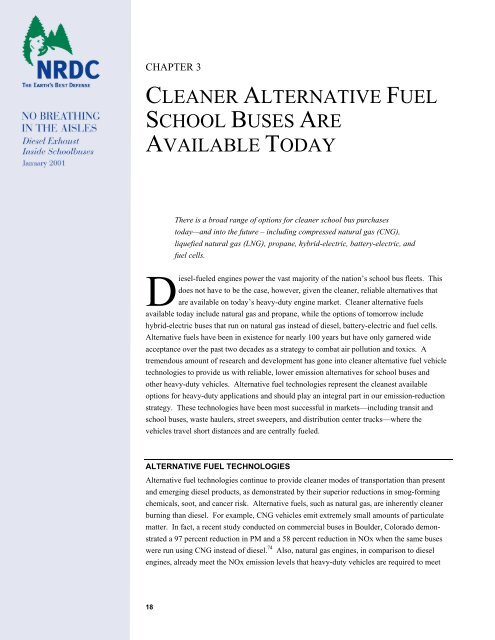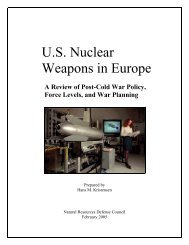NRDC: No Breathing in the Aisles: Diesel Exhaust Inside School ...
NRDC: No Breathing in the Aisles: Diesel Exhaust Inside School ...
NRDC: No Breathing in the Aisles: Diesel Exhaust Inside School ...
Create successful ePaper yourself
Turn your PDF publications into a flip-book with our unique Google optimized e-Paper software.
CHAPTER 3<br />
CLEANER ALTERNATIVE FUEL<br />
SCHOOL BUSES ARE<br />
AVAILABLE TODAY<br />
18<br />
There is a broad range of options for cleaner school bus purchases<br />
today—and <strong>in</strong>to <strong>the</strong> future – <strong>in</strong>clud<strong>in</strong>g compressed natural gas (CNG),<br />
liquefied natural gas (LNG), propane, hybrid-electric, battery-electric, and<br />
fuel cells.<br />
<strong>Diesel</strong>-fueled eng<strong>in</strong>es power <strong>the</strong> vast majority of <strong>the</strong> nation’s school bus fleets. This<br />
does not have to be <strong>the</strong> case, however, given <strong>the</strong> cleaner, reliable alternatives that<br />
are available on today’s heavy-duty eng<strong>in</strong>e market. Cleaner alternative fuels<br />
available today <strong>in</strong>clude natural gas and propane, while <strong>the</strong> options of tomorrow <strong>in</strong>clude<br />
hybrid-electric buses that run on natural gas <strong>in</strong>stead of diesel, battery-electric and fuel cells.<br />
Alternative fuels have been <strong>in</strong> existence for nearly 100 years but have only garnered wide<br />
acceptance over <strong>the</strong> past two decades as a strategy to combat air pollution and toxics. A<br />
tremendous amount of research and development has gone <strong>in</strong>to cleaner alternative fuel vehicle<br />
technologies to provide us with reliable, lower emission alternatives for school buses and<br />
o<strong>the</strong>r heavy-duty vehicles. Alternative fuel technologies represent <strong>the</strong> cleanest available<br />
options for heavy-duty applications and should play an <strong>in</strong>tegral part <strong>in</strong> our emission-reduction<br />
strategy. These technologies have been most successful <strong>in</strong> markets—<strong>in</strong>clud<strong>in</strong>g transit and<br />
school buses, waste haulers, street sweepers, and distribution center trucks—where <strong>the</strong><br />
vehicles travel short distances and are centrally fueled.<br />
ALTERNATIVE FUEL TECHNOLOGIES<br />
Alternative fuel technologies cont<strong>in</strong>ue to provide cleaner modes of transportation than present<br />
and emerg<strong>in</strong>g diesel products, as demonstrated by <strong>the</strong>ir superior reductions <strong>in</strong> smog-form<strong>in</strong>g<br />
chemicals, soot, and cancer risk. Alternative fuels, such as natural gas, are <strong>in</strong>herently cleaner<br />
burn<strong>in</strong>g than diesel. For example, CNG vehicles emit extremely small amounts of particulate<br />
matter. In fact, a recent study conducted on commercial buses <strong>in</strong> Boulder, Colorado demonstrated<br />
a 97 percent reduction <strong>in</strong> PM and a 58 percent reduction <strong>in</strong> NOx when <strong>the</strong> same buses<br />
were run us<strong>in</strong>g CNG <strong>in</strong>stead of diesel. 74 Also, natural gas eng<strong>in</strong>es, <strong>in</strong> comparison to diesel<br />
eng<strong>in</strong>es, already meet <strong>the</strong> NOx emission levels that heavy-duty vehicles are required to meet
















